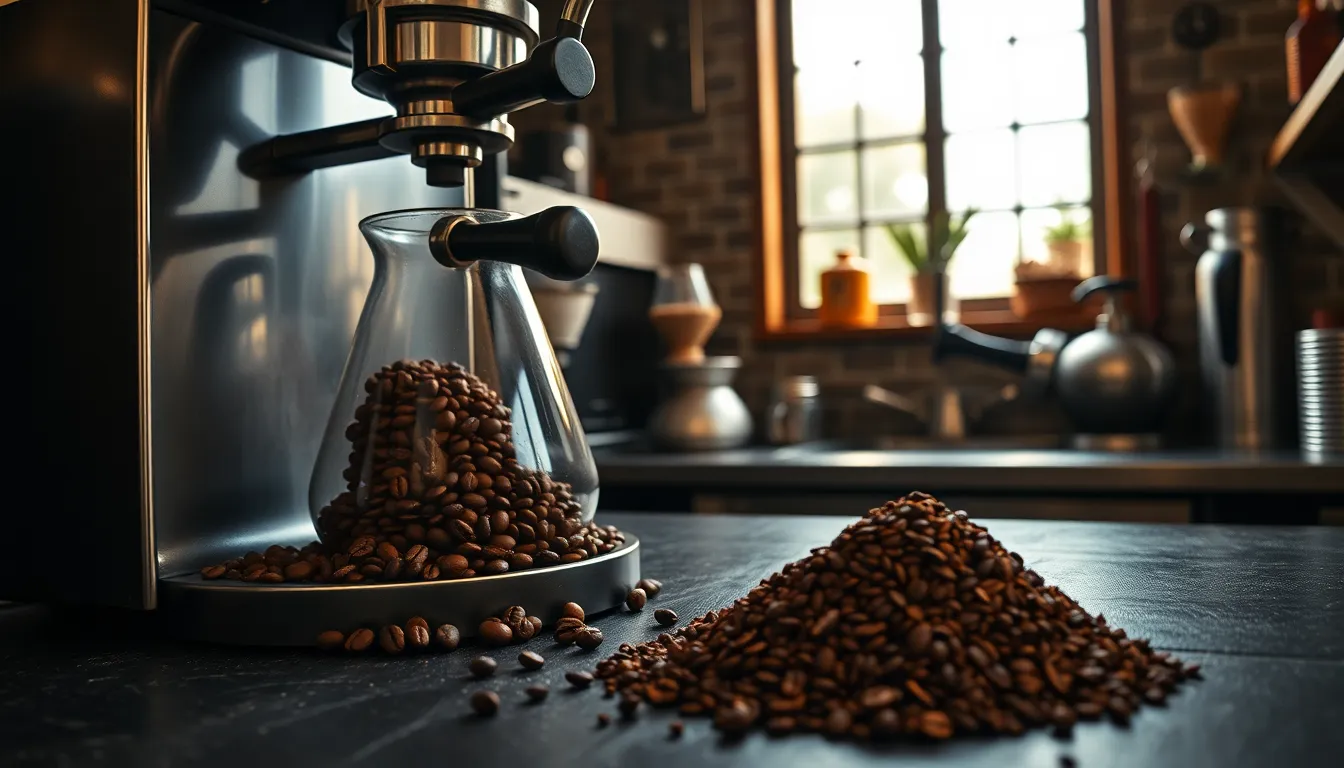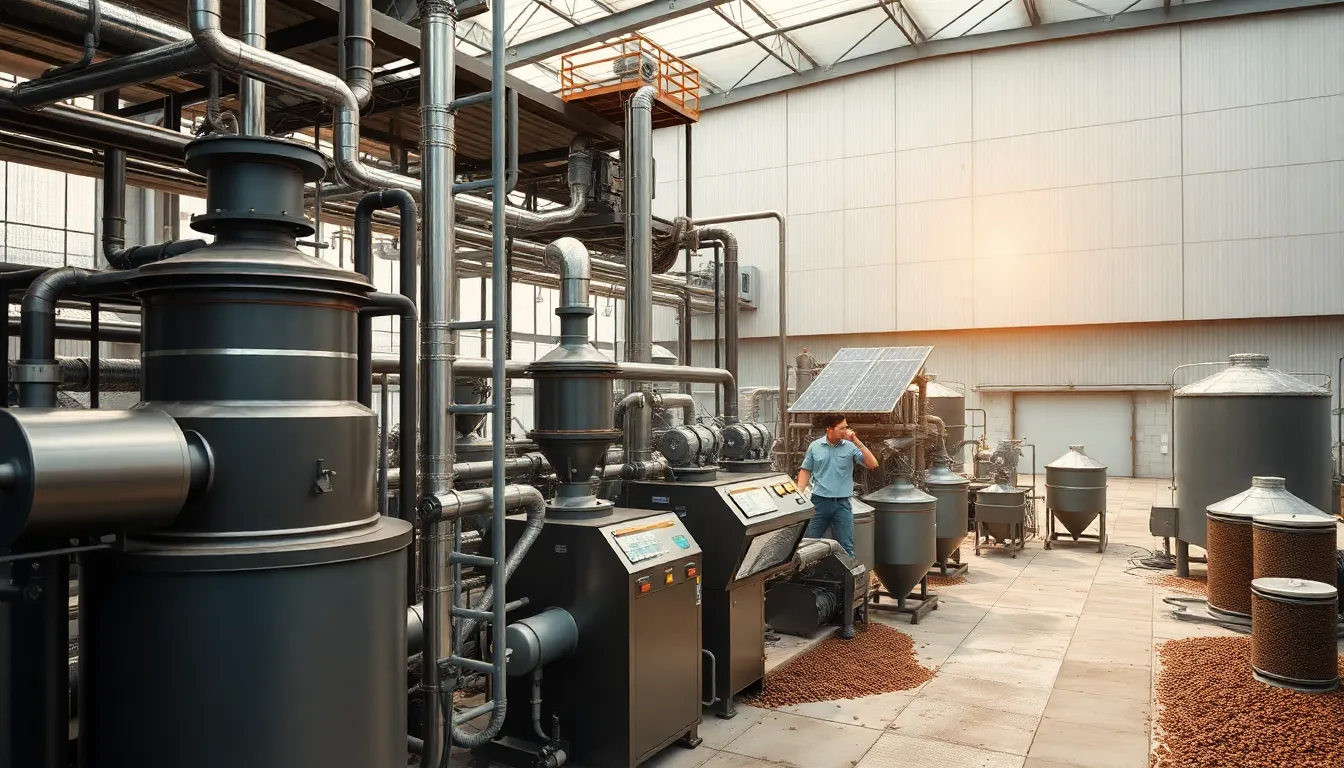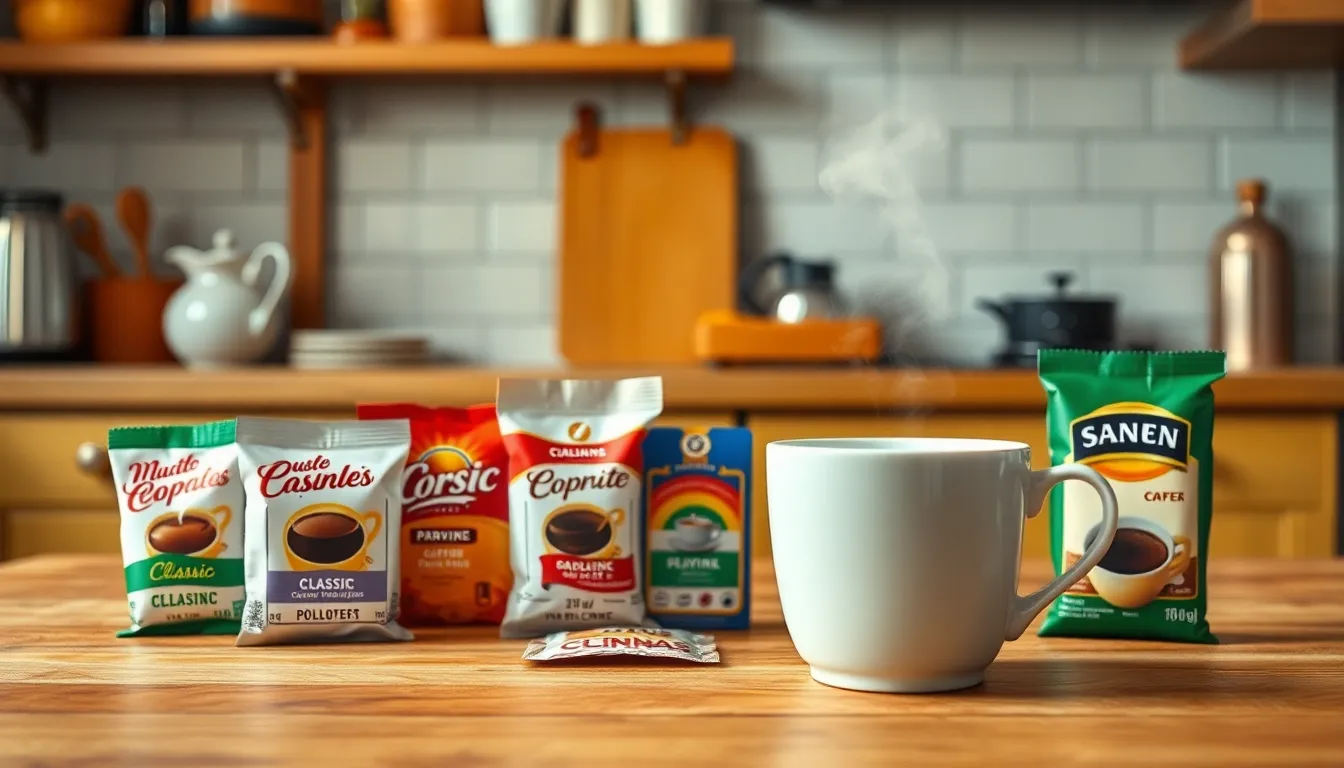What is instant coffee and why has it become such a staple in kitchens worldwide? This convenient coffee option offers a quick caffeine fix with minimal preparation—just add hot water and you’re ready to go.
Instant coffee begins as brewed coffee that’s been processed into soluble powder or granules. The manufacturing process typically involves brewing coffee concentrate, then removing the water through freeze-drying or spray-drying techniques. While it might not deliver the complex flavor profile of freshly ground beans, modern instant coffees have come a long way in quality and taste. You’ll find varieties ranging from basic blends to premium options with specialized flavors and origins, making this quick-brew method more appealing than ever for busy coffee lovers.
What Is Instant Coffee?
Instant coffee is a type of coffee made from whole coffee beans that have been roasted, ground, brewed, and then dehydrated into soluble powder or granules. When you add hot water to these granules, they dissolve completely, recreating a cup of coffee without any brewing equipment or waiting time. This convenient form of coffee was first invented in 1881, but the first successful instant coffee product, Nescafé, wasn’t commercialized until 1938.
The manufacturing process involves two primary methods: spray-drying and freeze-drying. Spray-drying sends concentrated coffee through hot air, quickly evaporating the liquid and leaving behind coffee particles. Freeze-drying, considered the superior method, freezes brewed coffee before removing the ice through sublimation, preserving more original flavor compounds.
Most major coffee brands offer instant varieties, including Nescafé, Folgers, Maxwell House, and Starbucks VIA. Specialty coffee companies like Sudden Coffee and Swift Cup now produce higher-quality instant options using single-origin beans and artisanal processing techniques, elevating the instant coffee experience for discerning drinkers.
The convenience factor makes instant coffee particularly popular in regions like the UK, Russia, Australia, and parts of Asia where traditional brewing methods aren’t as deeply entrenched. You’ll find instant coffee in diverse forms, from basic economy brands to premium varieties with distinct flavor profiles targeting coffee enthusiasts seeking both convenience and quality.
History and Evolution of Instant Coffee

Instant coffee’s journey spans over a century, transforming from a rudimentary invention to a sophisticated beverage option enjoyed worldwide. The evolution of instant coffee reflects advancements in food technology and changing consumer preferences for convenience without sacrificing flavor.
The Invention of Instant Coffee
Instant coffee first appeared in 1890 in Invercargill, New Zealand, marking the beginning of a revolution in coffee consumption. The early versions bore little resemblance to today’s refined products, offering basic flavor profiles and often lacking the aromatic qualities of freshly brewed coffee. During the early 20th century, various inventors attempted to improve the process, but the breakthrough came in 1938 when Nescafé launched the first commercially successful instant coffee product. This innovation addressed the important coffee surpluses in Brazil while meeting the growing demand for convenient coffee options during wartime, when traditional brewing methods weren’t always practical.
Modern Production Methods
Today’s instant coffee production utilizes two primary techniques that have dramatically improved quality and taste profiles. Spray drying involves spraying concentrated coffee extract into a stream of hot air, causing the liquid to evaporate instantly and leaving behind fine coffee powder. Freeze-drying, the more premium method, preserves more flavor compounds by freezing the coffee extract and then removing ice through sublimation under vacuum conditions. Major manufacturers invest millions in research to refine these processes, resulting in products that capture more of the 800+ aromatic compounds found in coffee. These technological advancements have enabled instant coffee to evolve from a merely convenient option to a respectable alternative that satisfies increasingly discerning coffee drinkers across various markets and price points.
How Instant Coffee Is Made

Instant coffee production transforms brewed coffee into convenient soluble granules through a sophisticated multi-stage process. The journey from bean to jar involves roasting, grinding, extraction, concentration, and finally, specialized drying techniques that preserve flavor while creating a shelf-stable product.
Spray-Drying Process
Spray-drying creates the fine powder form of instant coffee through an efficient high-temperature method. During this process, concentrated coffee extract is sprayed as tiny droplets into a chamber filled with hot air (often exceeding 250°F). These droplets dry almost instantly as they fall through the heated chamber, forming microscopic coffee particles. The resulting powder has a uniform texture and dissolves quickly in water, making it perfect for everyday use. Though this method is cost-effective and produces consistent results, it can sometimes sacrifice some of the coffee’s more delicate aromatic compounds due to the intense heat exposure.
Freeze-Drying Process
Freeze-drying preserves more of coffee’s original flavors through a sophisticated low-temperature dehydration technique. This premium process begins by freezing concentrated coffee extract at temperatures around -40°F, transforming it into coffee ice. The frozen coffee is then broken into granules and placed in vacuum chambers where sublimation occurs—ice converts directly to vapor without passing through a liquid state. This gentle process maintains the coffee’s cellular structure and locks in flavor compounds that would otherwise be lost with heat-based methods. Freeze-dried instant coffee typically features larger, more porous granules that reconstitute with a richer flavor profile closer to freshly brewed coffee. Though more expensive to produce, this method results in a notably superior product that’s favored by discerning coffee drinkers.
Types of Instant Coffee Products

Instant coffee comes in several varieties, each offering different taste profiles, quality levels, and price points. These products range from everyday staples to gourmet options designed for discerning coffee enthusiasts.
Regular Instant Coffee
Regular instant coffee represents the most common and accessible form of soluble coffee available in supermarkets worldwide. These products dissolve completely in hot water without leaving any residue, creating a cup of coffee in seconds with minimal effort. Most regular instant coffees are made from robusta beans or blends that prioritize consistent flavor and affordability rather than complex taste profiles. You’ll find these products in various roast levels from light to dark, including decaffeinated options for those watching their caffeine intake. Regular instant coffee typically costs less than ground coffee while offering significantly longer shelf life when stored properly in a cool, dry place. Many consumers enhance their regular instant coffee with milk, sugar, or flavored syrups like vanilla or caramel to customize the taste experience.
Premium and Specialty Instant Coffee
Premium and specialty instant coffees elevate the instant coffee experience with higher-quality beans and more sophisticated processing methods. These products often feature single-origin arabica beans from exact regions known for distinctive flavor profiles, such as Ethiopian Yirgacheffe or Colombian Supremo. The manufacturing process for premium instant coffee emphasizes preserving delicate flavor compounds and aromatic qualities that regular instant coffee might lose during production. Freeze-drying techniques are commonly employed for these products as they better maintain the coffee’s original characteristics compared to spray-drying methods. Many specialty coffee companies now offer instant versions of their signature blends, addressing the needs of coffee connoisseurs who value both quality and convenience. Premium instant coffees typically come in individual serving packets or small batches to maintain freshness and justify their higher price point. Even though costing more than regular instant coffee, these premium options remain less expensive than daily café purchases while delivering significantly improved flavor complexity and depth.
Taste Profile Compared to Regular Coffee

Instant coffee offers a distinctly different flavor experience compared to freshly ground coffee. The taste profile of instant coffee is typically more straightforward and mild, often carrying subtle bitter notes and occasionally a metallic aftertaste. This flavor difference stems primarily from the use of Robusta beans in instant coffee production, which naturally possess more earthy and bitter characteristics than the Arabica beans commonly used in ground coffee.
Flavor Complexity
The dehydration process significantly impacts instant coffee’s flavor complexity. During spray-drying or freeze-drying, many of the delicate flavor compounds found in freshly brewed coffee deteriorate, resulting in a simpler taste profile. Regular ground coffee preserves these volatile compounds, allowing you to experience a richer spectrum of flavors including fruity, floral, nutty, or chocolatey notes depending on the bean’s origin and roasting method.
Flavor Consistency
One advantage of instant coffee lies in its remarkable consistency. Each cup delivers virtually identical flavor since the product comes pre-brewed and standardized during manufacturing. This reliability makes instant coffee appealing if you value predictability in your daily coffee routine. Ground coffee, by contrast, varies substantially based on factors like bean origin, roast level, grind size, and brewing technique—offering a more diverse but less consistent experience.
Texture and Mouthfeel
Instant coffee generally lacks the natural oils present in freshly brewed coffee, resulting in a thinner mouthfeel. Many instant coffee brands compensate for this by incorporating additives such as vanilla or caramel flavoring to enhance palatability. Regular ground coffee retains more soluble solids and oils during brewing, contributing to a fuller body and creamier texture that most coffee connoisseurs prefer.
Caffeine Content
The caffeine content in instant coffee typically ranges from 60-80 mg per cup, notably lower than regular brewed coffee which contains approximately 80-120 mg per cup. This difference occurs because the brewing process for ground coffee allows greater control over caffeine extraction—longer brewing times increase caffeine content, giving you more flexibility to adjust strength according to your preference.
Health Considerations and Caffeine Content

Instant coffee contains significantly less caffeine than regular brewed coffee, making it an excellent choice for those monitoring their caffeine intake. A typical 225 ml cup of instant coffee provides approximately 66 mg of caffeine, which is nearly half the amount found in the same volume of drip or filter coffee (about 112 mg). This reduced caffeine content results directly from the processing methods used during production.
The antioxidant profile of instant coffee remains impressive even though the processing it undergoes. Each 180 ml cup delivers around 320 mg of polyphenol antioxidants, compared to roughly 400 mg in traditional brewed coffee. These antioxidants contribute to the potential health benefits associated with coffee consumption.
Iron absorption is notably affected by instant coffee consumption. Drinking instant coffee with meals can reduce intestinal iron absorption to less than 1%, which is even more pronounced than the reduction caused by drip coffee (approximately 1.6%). This inhibitory effect disappears when you consume coffee an hour before eating but returns if you drink coffee within an hour after your meal. This information is particularly relevant for individuals at risk of iron deficiency.
Convenience benefits extend beyond just preparation time. Instant coffee offers a long shelf life without refrigeration, reducing food waste compared to brewed coffee that often gets discarded when made in excess. The absence of grounds or filters also means less waste production, making it an environmentally conscious choice for regular coffee drinkers.
Different variants cater to exact health preferences, including decaffeinated options for those avoiding caffeine entirely and various roast levels that affect both flavor profile and chemical composition. Dark roasts typically contain less caffeine but more antioxidant compounds compared to lighter roasts, allowing you to select the option that best aligns with your health goals.
Popular Brands and Market Trends

Nescafé stands as the undisputed global leader in the instant coffee market, pioneering commercial success since 1938 with their innovative soluble coffee product. Major brands like Folgers and Maxwell House dominate grocery store shelves in North America, offering consistent quality at accessible price points. Starbucks has entered the instant coffee arena with their VIA line, bringing cafe-quality flavors to the convenience sector.
The instant coffee market has evolved significantly in recent years, responding to consumer demands for both convenience and quality. Premium instant coffee options from specialty producers like Mount Hagen and Sudden Coffee now cater to discerning coffee enthusiasts who value both time and taste. These specialty brands often use 100% arabica beans and advanced freeze-drying techniques to preserve complex flavor profiles.
Regional preferences shape the instant coffee industry worldwide:
- Asian markets favor 3-in-1 mixes combining coffee, creamer, and sweetener
- European consumers typically prefer stronger, more robust instant varieties
- Australian and New Zealand markets embrace both basic and premium options
- Middle Eastern regions show growing interest in flavored instant coffees
The environmental impact of instant coffee production has become an important market consideration. Many manufacturers now highlight sustainable sourcing practices and recyclable packaging to appeal to eco-conscious consumers. The reduced waste compared to pod-based systems gives instant coffee an environmental advantage that resonates with sustainability-focused buyers.
Price segmentation remains clear in the instant coffee market, with products available at entry-level ($3-5 per jar), mid-range ($6-10), and premium tiers ($11-20). This stratification allows consumers to select products based on their budget constraints and quality expectations, contributing to instant coffee’s continued relevance in a competitive beverage marketplace.
Environmental Impact and Sustainability

Instant coffee production demands substantial energy resources throughout its multi-stage manufacturing process. Roasting, grinding, brewing, and drying operations consume important amounts of energy and water, contributing to the product’s environmental footprint. The energy-intensive freeze and spray drying stages particularly generate greenhouse gas emissions due to their high power requirements.
Manufacturing a single jar of instant coffee involves complex extraction processes where hot water (up to 175°C) under pressure passes through multiple columns of ground coffee. This energy-demanding process extracts coffee solids, sugars, and caffeine to create a concentrated solution containing 20-25% soluble solids. Further concentration techniques—including evaporation, centrifugation, and freezing—increase this concentration to approximately 40% before the final drying stage begins.
Coffee brands are increasingly implementing sustainability initiatives to address these environmental concerns. Leading manufacturers have begun adopting more energy-efficient technologies and water conservation practices throughout their production facilities. Some companies now use renewable energy sources to power their operations, reducing the carbon footprint associated with instant coffee manufacturing.
Resource management represents another critical sustainability challenge in instant coffee production. The important water usage during extraction and processing has prompted industry leaders to develop water recycling systems and carry out closed-loop manufacturing processes. These innovations help minimize waste and conserve valuable resources while maintaining product quality.
Packaging considerations also factor into instant coffee’s environmental impact. Glass jars, while recyclable, require substantial energy to produce and transport due to their weight. Plastic containers present different environmental challenges related to disposal and recycling. Several brands now offer alternative packaging answers including compostable options and containers made from recycled materials to reduce their products’ lifecycle impact.
Conclusion
Instant coffee has transformed from a simple convenience product to a diverse category offering options for every taste and budget. Today’s market features everything from basic everyday blends to premium single-origin varieties that rival traditional brewing methods.
Whether you’re a busy professional needing a quick caffeine fix or a thoughtful consumer concerned about sustainability you’ll find an instant coffee that meets your needs. The industry continues to innovate with improved production techniques that preserve more flavor while working toward reducing environmental impact.
While it may never completely replace freshly brewed coffee instant coffee has earned its place in kitchens worldwide by balancing convenience quality and accessibility. It’s no longer just a compromise but a legitimate choice for millions of coffee drinkers around the globe.
Frequently Asked Questions
What is instant coffee?
Instant coffee is a convenient form of coffee made from whole beans that are roasted, ground, brewed, and then dehydrated into soluble powder or granules. When hot water is added, it dissolves quickly to create a cup of coffee without brewing equipment. Invented in 1881 and commercially successful since 1938 with Nescafé, instant coffee offers convenience while modern versions provide improved flavor profiles compared to earlier products.
How is instant coffee made?
Instant coffee is produced through a multi-stage process. First, coffee beans are roasted and ground, then brewed to create a concentrated extract. This extract is then dehydrated using either spray-drying (spraying into hot air to create powder) or freeze-drying (freezing the extract then removing ice through sublimation). Freeze-drying is more expensive but better preserves the coffee’s original flavors and aromas.
Is instant coffee less healthy than regular coffee?
No, instant coffee isn’t inherently less healthy than regular coffee. It contains less caffeine (approximately 30-90mg per cup versus 70-140mg in regular coffee) and retains many of the beneficial antioxidants found in regular coffee. Some studies suggest it may have higher levels of certain antioxidants due to the concentration process. As with regular coffee, moderation is key for health benefits.
Does instant coffee taste different from regular coffee?
Yes, instant coffee typically has a more straightforward flavor profile than regular coffee. It often lacks the complex flavor notes and aromatic compounds found in freshly brewed coffee due to the dehydration process. Instant coffee generally offers more consistency in taste but less depth and complexity. Premium instant coffees use better beans and freeze-drying to preserve more authentic coffee flavors.
Which brands offer the best instant coffee?
Leading instant coffee brands include Nescafé (global market leader), Folgers, and Starbucks Via. For premium options, specialty producers like Swift Cup Coffee, Sudden Coffee, and Voilà offer higher-quality instant coffees made from specialty-grade beans. These premium brands focus on preserving complex flavor profiles through advanced freeze-drying techniques, though they come at a higher price point than traditional instant coffee.
How long does instant coffee last?
Instant coffee has an impressive shelf life, typically lasting 1-2 years when stored properly in its unopened original packaging. Once opened, it remains good for 2-3 months if kept in an airtight container away from heat, light, and moisture. Unlike ground coffee, which loses freshness quickly, instant coffee’s dehydrated form preserves its quality for much longer periods without significant degradation.
Is instant coffee more environmentally friendly than regular coffee?
The environmental impact of instant coffee is mixed. While it requires less coffee per cup than traditional brewing methods (reducing resource use at the farm level), its production is energy and water-intensive. However, it generates less waste from spent grounds and doesn’t require paper filters. Some brands now use sustainable packaging and production methods. For maximum eco-friendliness, look for brands with sustainable sourcing and recyclable packaging.
Can I use instant coffee for baking and cooking?
Absolutely! Instant coffee is excellent for culinary applications. It dissolves completely without leaving grounds, making it ideal for baking, marinades, rubs, and desserts. It adds coffee flavor without additional liquid, perfect for recipes like tiramisu, coffee cakes, brownies, and chocolate desserts. It can also enhance the flavor of savory dishes like chili and beef stew by adding depth and richness.
Are there different types of instant coffee?
Yes, instant coffee comes in several varieties. Regular instant coffee is made from robusta beans or blends, offering consistent flavor at affordable prices. Premium instant coffees use higher-quality arabica beans and advanced processing techniques for better flavor. Specialized options include flavored varieties, instant coffee with added ingredients like creamer or sugar, decaffeinated versions, and various roast levels from light to dark.
How does the caffeine content in instant coffee compare to regular coffee?
Instant coffee contains less caffeine than regular brewed coffee. On average, a cup of instant coffee contains about 30-90mg of caffeine, while regular brewed coffee provides 70-140mg per cup. This lower caffeine content makes instant coffee a suitable option for those looking to reduce their caffeine intake while still enjoying coffee. The exact amount varies by brand, serving size, and coffee type.

